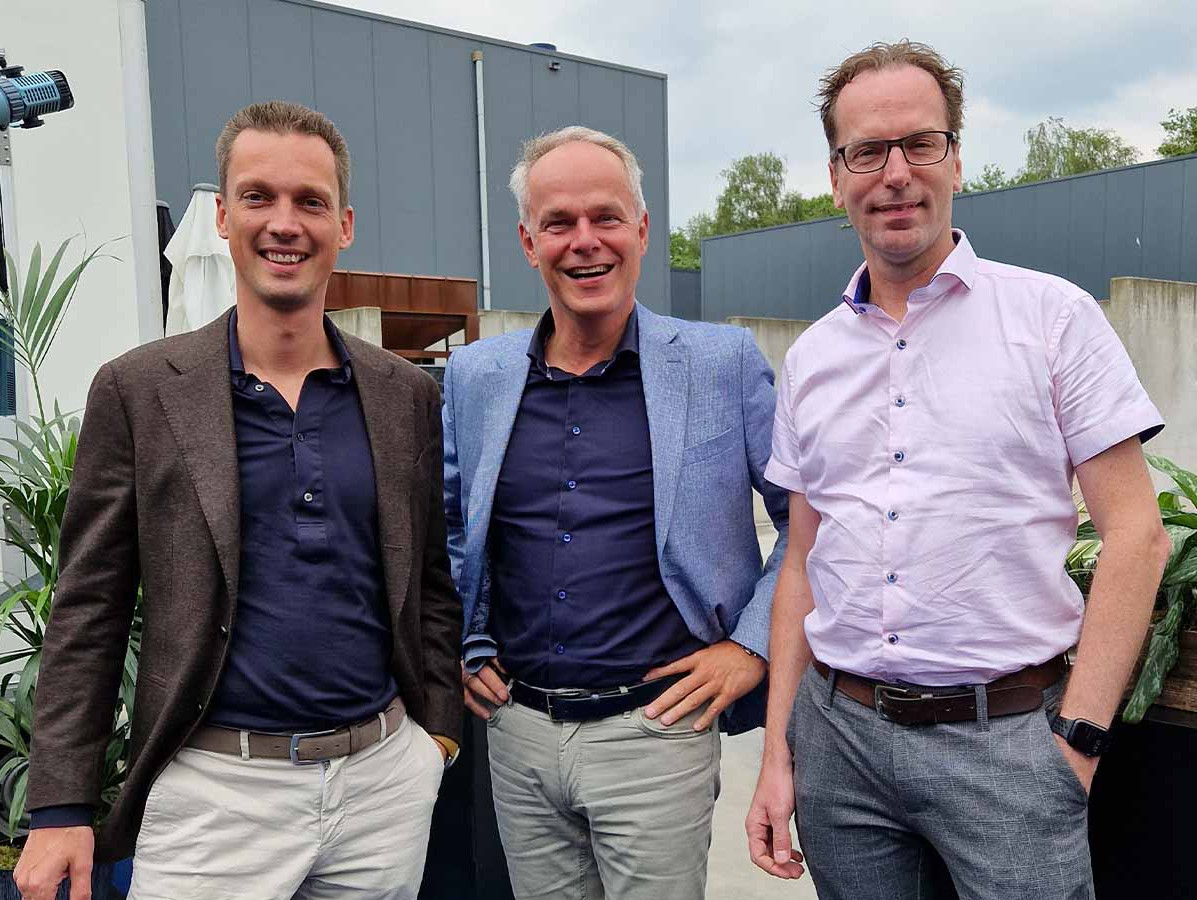
You want to expand or renovate. So, you decide to build! Once you’ve made that decision, questions start arising. What materials will you choose? Are they sustainable? How does this choice affect fire safety? What about the food safety of the solution? What energy source will the factory operate on? And where will you get your power from? Building in the food industry involves making a lot of choices.
The lack of power and power connections is the biggest bottleneck in the sector; this won’t surprise anyone. It’s also the first issue brought up at the table where Gerard Scherff, Commercial Director at K.I.M. Nederland, Cordy Volkers, Partner and Senior Project Manager at Bessels Architecten & Ingenieurs, and Bas te Riele, Commercial Project Manager at Bouwbedrijf Aan de Stegge Twello, are gathered. These men know each other well from numerous collaborations over the years: beautiful construction projects for companies in the food industry.
Bas notes a shift in the market: “Brownfield locations are increasingly preferred,” he says, “because they already have electrical connections and a network in place. However, even then, the capacity can be insufficient. Waiting times for expansions can be as long as 2 to 3 years. Generating power through other means is possible, for example with solar energy. However, this usually doesn’t produce enough, and you often can’t return the excess capacity to the grid. During peak loads and in winter, a generator is sometimes necessary. This is tricky as it conflicts with nitrogen policies.”
“It’s a vicious cycle. To solve the nitrogen problem, you need to electrify. But electricity is becoming increasingly unavailable in many locations,” agrees Cordy. “Interestingly, sometimes a solution suddenly appears, a good connection becomes available, and a new location is quickly developed. Unfortunately, there’s no consistent pattern.”
However, this bottleneck also has a positive side, according to the architect. “It forces parties to think more creatively about how to use other energy sources more efficiently to achieve their plans. We see that more often, brownfield locations are being equipped with solar panels combined with high-capacity batteries; these can meet the demand during periods of low power availability. By smoothing out peaks, you can still build and expand, and keep the same connection. For instance, a cold storage facility acts as a battery in terms of retaining cold. The facility can be periodically shut down to prevent overloading the power grid. At night, when neighborhood demand is low, the power supply is switched back on. It’s a practical solution to regulate power demand.”
A second challenge, according to Bas, is “that potential clients often underestimate what’s needed to build food grade facilities. As a food entrepreneur, you must make many considerations. Price differences arise purely based on content; we make this clear in the first discussions. Everyone knows that a factory needs floors, drains, and gutters, but how do you get water to the drains and gutters? Do you make the floor flat and use a squeegee to direct the water to the drains? This increases the likelihood of water remaining on the floor. Or do you choose the option where a second floor is laid on top of the concrete floor with the necessary slopes to meet hygiene requirements, ensuring the water flows into the drains and gutters? What type of sewage system will you use? PVC, polyethylene, or stainless steel? The quality you choose makes a significant difference in cost per meter, but also in quality and lifespan. Do you embed the sewer pipe to prevent it from sagging and clogging, or do you suspend it with straps? The latter is cheaper, but carries more risk of issues. Do you choose a standard door or one made of stainless steel? Do you include collision protection or not? Skipping this is cheaper, but how will you maintain it in the future? Replacing a damaged door frame is more expensive. How do you manage clean zones within the factory as staff move from low to medium and high-care zones? You may not have a problem now, but what if hygiene standards become stricter? You must plan for this now with structural provisions, such as having staff move via a staircase rather than through all the rooms. What the entrepreneur does or doesn’t do is their own choice. It’s our role, or the team’s, to guide the entrepreneur in making all these considerations. We always ensure they are part of the process.”

From left to right: Gerard Scherff, Bas te Riele and Cordy Volkers
Cordy: “Sustainability and integrating your building into the environment are increasingly important. The trend is to build properties that are nature-inclusive, bio-based, and demountable. Sometimes requirements clash: if you want to build food safe, you must meet food safety standards. Although much of the construction can be dismantled, the steel structure is often cast in place for food safety reasons. If you build the structure on top of the floor so it can be dismantled in 20 or 30 years, you need to consider many details. Another aspect is sunlight. The greatest solar exposure is through the roof. A white roof covering is often chosen to reduce heat load. However, a white roof turns gray in six months and black in a year. It’s better to interrupt the sunlight with, for instance, solar panels. This also creates a roof with high insulation value. The glass panels have a protective coating with a self-cleaning function, so they don’t get dirty as quickly. Nowadays, we always build roofs with a reinforced structure to support the panels.”
“Insulation panels can also be made more sustainable,” Gerard adds. “This is crucial for cold and freezer storage. The better the insulation, the less energy you use. Given current energy prices, it’s very worthwhile to consider this. We now use QuadCore panels, which have a 10% higher insulation value than PIR panels from our regular supplier. As a result, they can be thinner and lighter than traditional PIR panels. This also significantly reduces transport costs and the associated CO2 emissions.”
KIM Nederland has been using QuadCore sandwich panels for about five years. “These have fire resistance up to one hour and a lower smoke reaction compared to other traditional PIR sandwich panels,” “Additionally, they have the important FM Global 4882 certification. According to the insurer and certifier Factory Mutual, this means they can be used in ‘Smoke Sensitive Occupations’ such as the food industry,” Gerard explains. “Increasing demands are being placed on fire safety,” he says. “During a major fire, important issues come to light. If your building burns down overnight, you can’t produce and deliver the next day. Fire safety is also about ensuring the continuity of your business. As an entrepreneur, you should want fire safety; your business is a lifeline for your employees, customers, and yourself.” Recently, KIM organized a major fire test in Urk. “To raise awareness beyond regulations,” Gerard explains. “During the test, we demonstrated the difference in fire reaction between insulation materials widely used in the past, such as Tempex and PUR, and the material we now and will use in the future: QuadCore. The visitors were really impressed; I think we woke them up.”
Bas agrees that it’s good to prioritize fire safety. “That’s obvious. But,” he notes, “insurers are increasingly demanding. Sometimes it goes too far. For example, an insurer might require sprinkler systems to be installed not only in new builds but also in existing buildings. The problem is that the entrepreneur then has to add extra piping in an existing production site. If there are sanitary ceilings, you can access them reasonably well, but sprinkler systems are relatively heavy. Those ceilings aren’t designed to support the additional weight.”
Cordy: “Sprinkler systems are a costly option for high-rise buildings and difficult to install in a cold storage facility. Water and freezing don’t mix well. An oxygen reduction system is an equivalent fire-safe solution. However, low oxygen levels pose safety risks for humans. It can only be applied in buildings with a high degree of automation where people don’t need to enter. It also requires very high airtightness standards for your building.”
“We build the most airtight cold and freezer storage facilities in the Netherlands, so that shouldn’t be a problem,” Gerard laughs. He continues: “Returning to roofs; insurers increasingly require non-combustible roof structures. They suggest stone wool for this. But stone wool is heavy and has poor insulation value; it’s not suitable for the cold and freezer sector.”
Cordy: “With solar panels on the roof, insurers and safety regions also set high standards.”
“Sometimes what’s demanded is technically unrealistic,” Gerard finds. “It must remain affordable and feasible. For smaller producers, the investments required are often unaffordable. With small innovations, we can often find solutions, but a good advisor is very important. Our new projects, such as a large cold-freezer storage facility in Dordrecht and on the Maasvlakte, are being fully equipped with 220 mm QuadCore roof panels. Solar panels will be installed on them. This has been approved by the authorities.”
Cordy: “The trend is that insurers change the rules during the game, especially after a major fire in the sector. That’s very frustrating.” Is there anything to be done about this? “Start discussions with the insurer and safety region early,” the three unanimously advise. “Make clear agreements with them and document everything!”
“You shouldn’t just involve the insurance representative from the start,” Cordy continues. “Also engage with the energy and water suppliers early on. This way, you can identify bottlenecks early. We perform a risk-opportunity assessment with the client and then immediately sit down with a construction team. A food factory is often seen by outsiders as a simple box. That’s a misconception; it involves a lot of expertise.”
Gerard: “Clients think they can save money by competitive bidding. We believe that if you want to build smartly, it’s best to assemble a construction team with parties that have expertise in every discipline and understand building in and for the food industry. This way, nothing gets overlooked.”
Bas also advocates for an integrated approach: “Due to stricter sustainability requirements and the energy crisis, much is changing. Existing installations need to be adapted. This often affects the building. By integrating everyone at the table, you arrive at a design that is budgeted at every stage. When you read in the newspaper that a project has become two or three times more expensive, I find it incomprehensible! That just doesn’t happen with us.”
Source: Vakblad Voedingsindustrie 2024